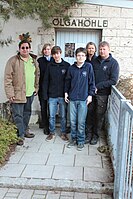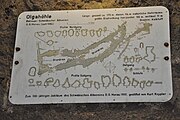Olga Cave
| Olga Cave
|
||
|---|---|---|
|
Olga Cave |
||
| Location: | Honau near Lichtenstein, district of Reutlingen , Baden-Württemberg | |
|
Geographic location: |
48 ° 24 '36 " N , 9 ° 15' 35" E | |
|
|
||
| Geology: | Tufa cave in the limestone tuff | |
| Type: | Primary cave , natural cave | |
| Discovery: | October 24, 1874 | |
| Show cave since: | 1875 | |
| Lighting: | electric (since 1884) | |
| Overall length: | about 170 m | |
| Level difference: | about 11 m | |
| Length of the show cave area: |
120 m | |
| Average annual number of visitors: | 2,400 (2014-2018) | |
| Current visitors: | 2,291 (2018) | |
| Particularities: | Primary cave , tuff cave | |
The Olgahöhle is the largest limestone cave in Germany. It is located in the Honau district of the municipality of Lichtenstein in Echaztal , on the eaves of the Swabian Alb below Lichtenstein Castle .
history
The cave was discovered by Johann Ziegler on October 24, 1874 in a tufa-lime quarry near Honau. The tufa, popular as a building material (not of volcanic origin!), Was quarried in numerous quarries in the area in the 19th century . The cave quickly attracted a lot of attention; on Whit Monday 1875 it was opened as an illuminated show cave on the day of the Nebelhöhlen Festival . As early as 1884, the candle lighting in the cave was replaced by electric light. The cave named after the Württemberg Queen Olga was the first electrically illuminated show cave in Germany. It was preceded in 1883 by the Austrian Kraushöhle near Gams in Styria ; In the same year, 1884, the Adelsberg Caves (Postojnska Jama) in present-day Slovenia received electrical lighting.
In the years 1901 to 1903 the Lichtenstein Festival was held on the square near the cave. A stage was built there for the performance of Wilhelm Hauff's work Lichtenstein , which was torn down again after the games were over. After the Second World War , the cave was closed for a few years because none of the heirs lived in Honau anymore. Finally the property with the inn was transferred to the Evangelical Methodist Church . Today there is a senior center there. The Swabian Alb Association reopened the cave, which took place in 1972. Today the Olga cave is looked after jointly by the Honau local group of the Swabian Alb Association and the Pfullingen cave research group. The Olga Cave is open between March and November on the first Sunday of the month.
Location and arrangement
The Olga cave is one of the rare primary caves (tuff caves), which means that it was created at the same time as the surrounding rock. It consists of two parallel corridors running across the Echaz valley, which are completely dry despite the proximity of the Echaz. After the discovery of the cave, both corridors were laid deeper, so that the lower part consists almost everywhere of stable limestone tufa sand. The ceiling is formed by hemispherical domes made of blue-green algae tuff. Cyanobacteria, formerly classified as blue-green algae , like mosses and algae, have the ability to photosynthesize , i.e. to absorb CO₂. Stalactites have formed on the wall and ceiling in several places . The walls are covered with bizarre rock shapes, mighty moss tuff blocks and limestone tuff domes. It is assumed that the cave was not simply built up by the tufa growing over the edge of the tufa bar, but that shifts or faults also played a role.
See also
Web links
- Official homepage of the Olga Cave
- Profile of the individual nature monument in the LUBW's list of protected areas
- Geotope profile at the State Office for Geology, Raw Materials and Mining
Individual evidence
- ↑ Information from the Swabian Alb Association local group Honau
literature
- Treatises on karst and speleology. Row A: Speleology. Issue 7. Mangold, Blaubeuren 1972, ISSN 0567-4956 .
- Hans Binder, Anke Luz, Hans Martin Luz: Show caves in Germany. Aegis, Ulm 1993, ISBN 3-87005-040-3 .




